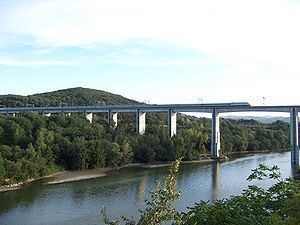Type Heavy rail Line length 254 km (158 mi) | Status Operational Province Province of Florence | |
 | ||
System Italian high-speed rail system Opened 24 February 1977completed on 26 May 1992 Track gauge 1,435 mm (4 ft 8 ⁄2 in) Operators Rete Ferroviaria Italiana, Ferrovie dello Stato Italiane | ||
The Florence–Rome high-speed railway line is a link in the Italian high-speed rail network. It is known as the ferrovia direttissima Firenze-Roma in Italian—meaning "most direct Florence–Rome railway" (abbreviated DD); this name reflects the naming of the Rome–Formia–Naples Direttissima opened in 1927 and the Bologna–Florence Direttissima opened in 1934. The line was the first high-speed line opened in Europe when more than half of it opened on 24 February 1977. It was completed on 26 May 1992, reducing the time of the fastest trains between the two cities to 1 hour and 20 minutes. The old line is referred to by Ferrovie dello Stato (the State Railways) as the Linea Lenta (meaning "slow line", abbreviated LL) to distinguish it from the parallel high-speed line.
Contents
Map of Ferrovia direttissima Firenze - Roma, 50063 Figline Valdarno FI, Italy
The line is currently being modified to meet the new Linea Alta Velocità/Alta Capacità (high-speed/high-capacity line, AV-AC) standard being established by Rete Ferroviaria Italiana for high-speed lines. The line is part of Corridor 1 of the European Union's Trans-European high-speed rail network, which connects Berlin and Palermo.
History
The 315 km railway between Rome and Florence developed from several different lines by several different companies for different purposes and as a result was curvy and slow. Over the years there had been many studies, proposals and projects for deviations to straighten the line but nothing came of them. After World War II it was finally decided to build a new line that was straighter, faster and especially shorter (237.5 km) than the old Florence-Rome line; it was also to be well-integrated with the existing line, rather than replace it. The project was approved and funded in late 1968 and early 1969. This was the first high-speed rail project—in the sense that "high-speed" is now used—to be commenced in Europe.
On 25 June 1970 work began on the most important element of the project: the 5,375 metre-long Paglia viaduct over the Paglia river, which is made up of 205 25 metre-long linear spans of and five 50 metre-long arched spans and is the longest viaduct in Europe. It was expected that the first 138 km section of the line from Roma Termini to Città della Pieve would take five years to complete, but it was not in fact opened until 24 February 1977. It was a milestone in the history of Italian railways, but progress was subsequently slowed by numerous obstacles, some of a political nature. The line had to be rerouted near Arezzo due to problems in driving a tunnel. The official opening took place with a train consisting of an FS Class E444 locomotive and Gran Comfort coaches.
The 51 km section of line between Città della Pieve and Arezzo was completed on 29 September 1985; the 20 km section between Valdarno and Florence was opened on 30 May 1986 and finally on 26 May 1992 the 44 km section between Arezzo and Valdarno was opened.
Route
The line has a largely straight path with a maximum slope of eight per thousand, no level crossings or intersections of any kind and the centre of tracks four metres apart to counteract the dynamic effects created by trains passing each other. Communication with drivers consists of an adaptation of the Italian RS4 Codici train protection system with in-cabin repetition of signals using nine codes and earth to train telephone communication. The minimum radius of curves is 3,000 meters, enabling an operating speed of 250 km/h. Connections between the two tracks in both directions every 16.2 kilometers allow trains to use either track in either direction or for all operations to operate on a single track if necessary.
The rails are laid using a UIC 60 kg/metre rail profile, with electrically welded rails attached to 2.30 metres-long prestressed reinforced concrete sleepers, spaced 60 cm apart with Pandrol clips. The interconnections between the high-speed lines and the old Florence–Bologna lines are implemented through lines that separate away from the opposing line and pass under or over both new lines rather than crossing over the opposing track on the level. The switches between the two running lines are capable of supporting speeds of up to 100 km/h, while the 15 switches to connecting lines support speeds of up to 160 km/h. The line is electrified at 3 kV DC, and supplied by substations at 16 km intervals. It is proposed to re-electrify the line at 25 kV AC and replace the signalling and train protection system with the European Train Control System to raise the maximum speed from 250 km/h to 300 km/h.
